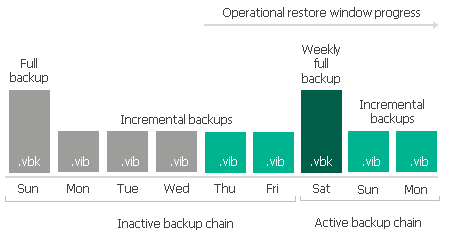 This is an archive version of the document. To get the most up-to-date information, see the current version.
This is an archive version of the document. To get the most up-to-date information, see the current version.Copying Backups to Capacity Tier
Veeam Backup & Replication allows you to copy backups from the performance extents of your scale-out backup repository to the capacity extent as soon as these backups are created.
To enable data copy, make sure to select the Copy backups to object storage as soon as they are created option, as described in Add Capacity Tier.
To copy data to the capacity extent, Veeam Backup & Replication uses a copy session that is executed automatically upon completion of a backup (or backup copy) job that is targeted to a scale-out backup repository that was extended with the capacity extent.
A complete name of each copy session is built up of the backup (or backup copy) job name plus Offload postfix. That is, if your backup (or backup copy) job name is Amazon, the copy session name will be Amazon Offload.
Before your data can be copied to the capacity tier, Veeam Backup & Replication performs the following mandatory verifications and required actions:
- Verifies whether performance extents are available and have not been put into the maintenance mode.
- Builds and maintains indexes to verify whether data that is being moved is unique and has not been offloaded earlier.
Backup files with metadata are created as described in Moving Backups to Capacity Tier.
Once the backup (or backup copy) job is complete, Veeam Backup & Replication initiates a new copy session which simply extracts data blocks and metadata from each new backup file (.VBK, .VIB, .VRB) created on any of the performance extents of your scale-out backup repository and copies these blocks and metadata to the capacity extent, thereby making an identical replica of your backup data.
Having such replica gives you the ability to quickly restore data as of the latest state in case of trouble with any backup files, any unexpected failure of any of your performance extents, or even of the entire scale-out backup repository, as described in Restore Scenarios.
Combining Copy and Move Operations
You can combine both the Copy backups to object storage as soon as they are created option and the Move backups to object storage as they age out of the operational restores window option. In such a scenario, a copy session will be copying newly created backups right upon creation.
Once the backup chain becomes inactive (for example, sealed) and exceeds the operational restore window, data blocks will be removed from each associated backup file in such an inactive backup chain and only metadata will be preserved. Such a behavior mimics data movement, but instead of moving data that was already copied, Veeam Backup & Replication simply purges associated data blocks from the performance extents, thereby saving traffic and reducing costs that might be incurred by your storage provider for performing read/write operations.
The following figure shows an example in which both options are enabled, suggesting that each backup file has been copied to object storage upon its creation.
The backup chain on the left becomes inactive after a new full backup file is created and consists of one .VBK file and five .VIB files. Since only the first four backup files (represented as grey blocks) in this inactive backup chain exceed the operational restore window, Veeam Backup & Replication removes blocks of data from these four files only and leaves the other two .VIB files (created on Thursday and Friday) as they are until the operational restore window moves forward, and so on.

After copy is complete, the new Object Storage node appears in the Home view, under the Backups node and shows backups that have been copied to the capacity extent.
Note |
The copy is not performed during prohibited hours specified in the scale-out backup repository backup window configuration. You can configure the backup window at the Add Capacity Tier step of the New Scale-out Backup Repository wizard. |
Related Topics